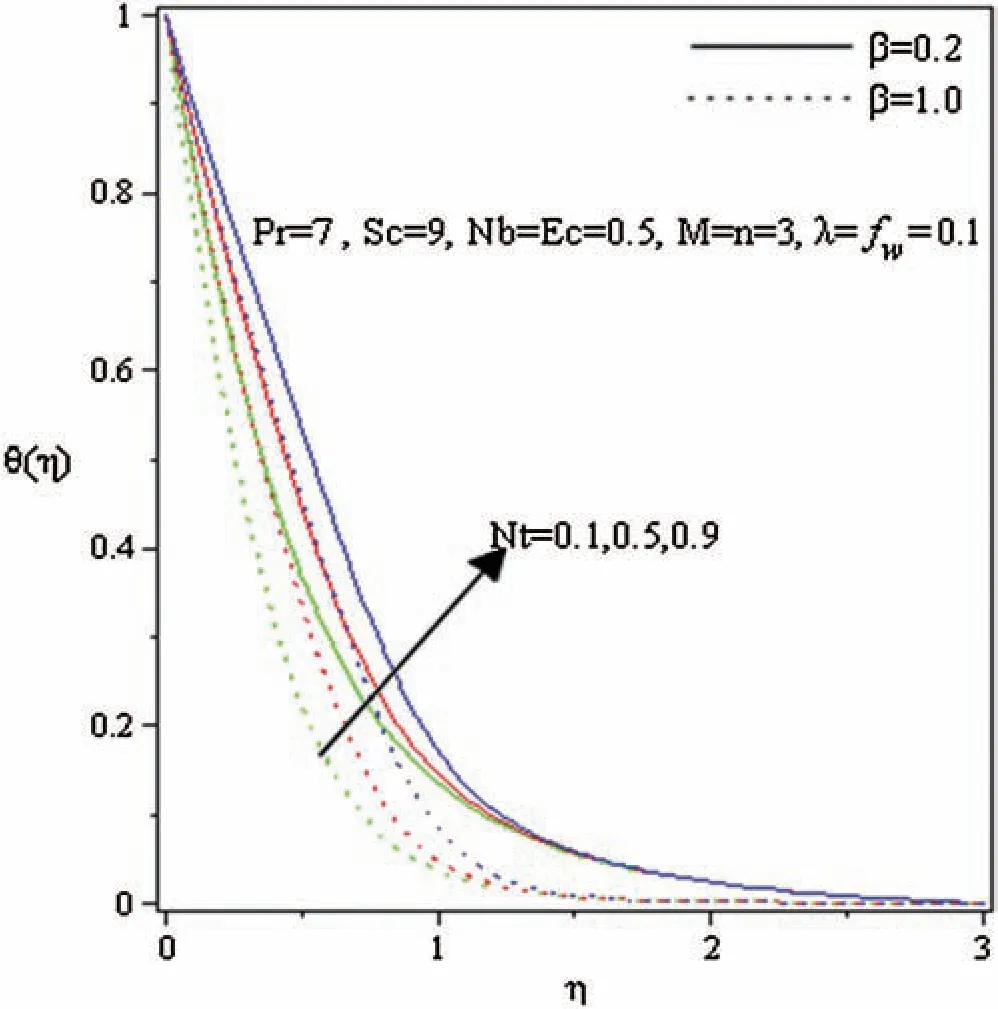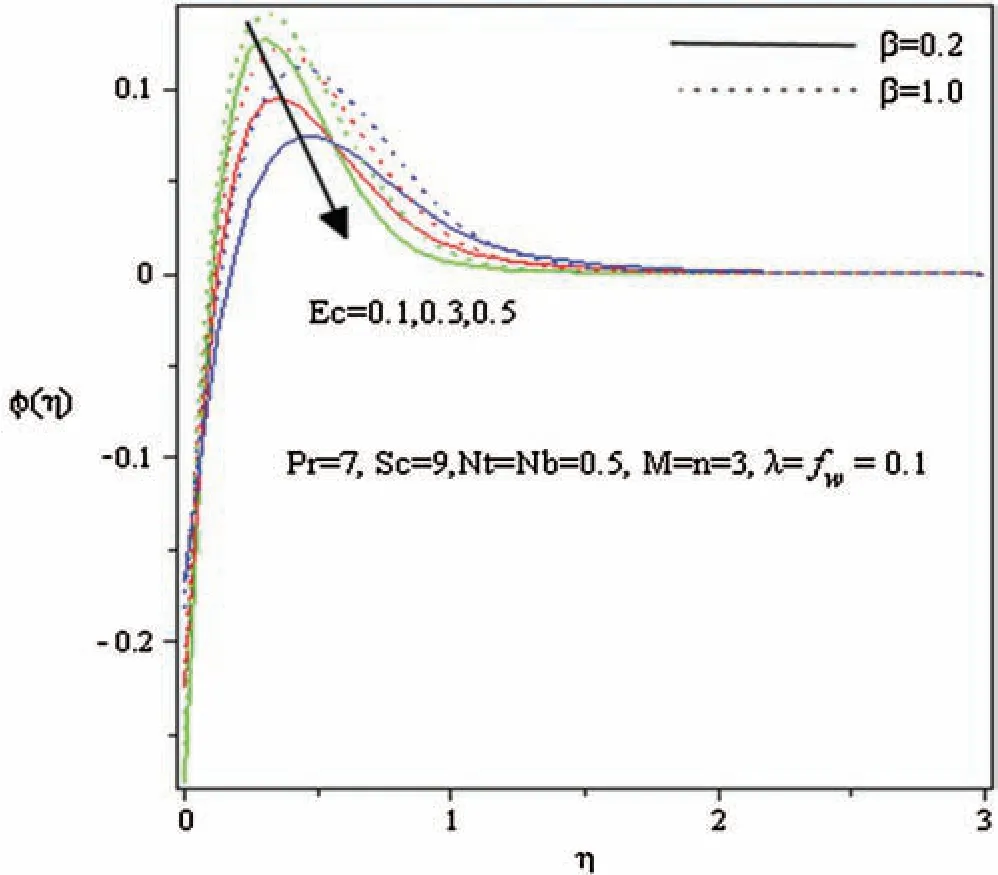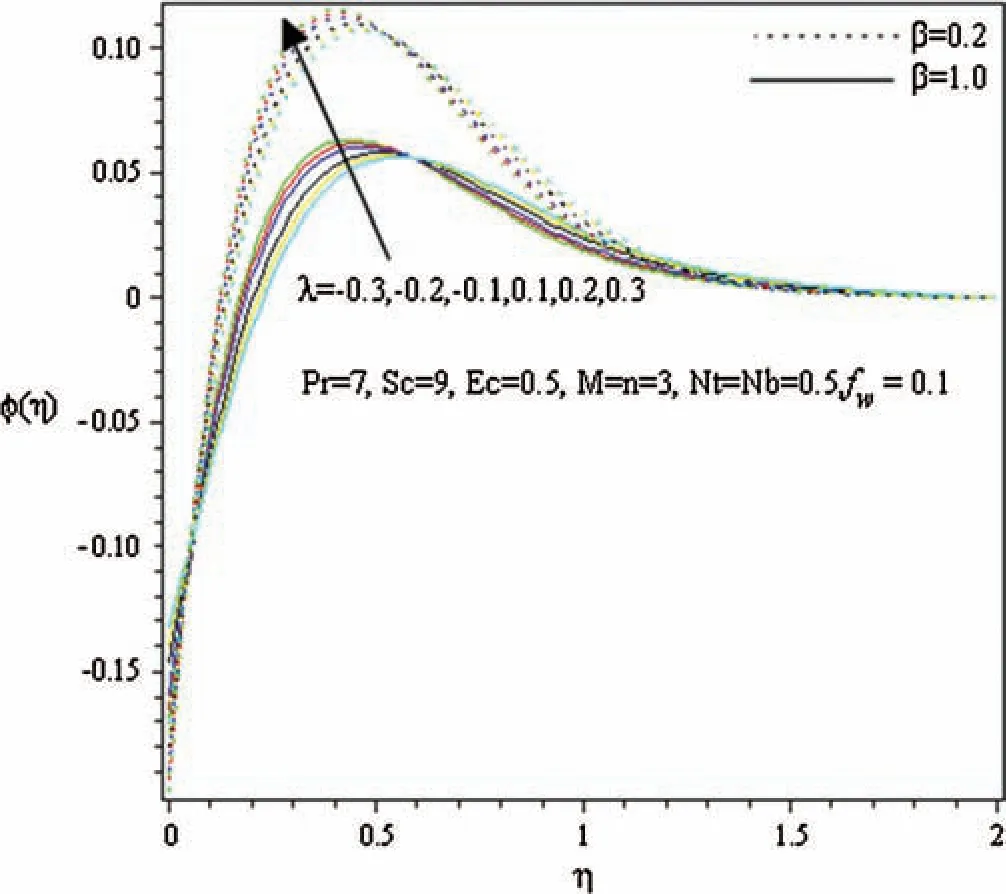Numerical Treatment of MHD Flow of Casson Nanofluid via Convectively Heated Non-Linear Extending Surface with Viscous Dissipation and Suction/Injection Effects
2021-12-14HammadAlotaibiSaeedAlthubitiMohamedEidandMahny
Hammad Alotaibi,Saeed Althubiti,Mohamed R.Eid and K.L.Mahny
1Department of Mathematics,Faculty of Science,Taif University,Taif,888,Saudi Arabia
2Department of Mathematics,Faculty of Science,New Valley University,Al-Kharga,Al-Wadi Al-Gadid,72511,Egypt
3Department of Mathematics,Faculty of Science,Northern Border University,Arar,1321,Saudi Arabia
4Sohag Technical Industrial Institute,Ministry of Higher Education,Egyptian Technical College,Sohag,Egypt
Abstract:This paper introduces the effect of heat absorption(generation)and suction(injection)on magnetohydrodynamic(MHD)boundary-layer flow of Casson nanofluid(CNF)via a non-linear stretching surface with the viscous dissipation in two dimensions.By utilizing the similarity transformations,the leading PDEs are transformed into a set of ODEs with adequate boundary conditions and then resolved numerically by(4–5)th-order Runge-Kutta Fehlberg procedure based on the shooting technique.Numerical computations are carried out by Maple 15 software.With the support of graphs,the impact of dimensionless control parameters on the nanoparticle concentration profiles,the temperature,and the flow velocity are studied.Other parameters of interest,such as the skin friction coefficient,heat,and mass transport at the diverse situation and dependency of various parameters are inspected through tables and graphs.Additionally,it is verified that the numerical computations with the reported earlier studies are in an excellent approval.It is found that the heat and mass transmit rates are enhanced with the increasing values of the power-index and the suction(blowing)parameter,whilst are reduced with the boosting Casson and the heat absorption(generation)parameters.Also,the drag force coefficient is an increasing function of the powerindex and a reduction function of Casson parameter.
Keywords:Casson nanofluid;viscous dissipation;MHD;heat generation;suction/injection
1 Introduction
Due to its large number of applications,the study of non-Newtonian fluids over an extending surface has attained great attention.In fact,the impacts of non-Newtonian behavior can be assessed by its elasticity,but their constitutive equations sometimes identify the rheological properties of the fluid.Provided the rheological parameters,the constitutive equations in the non-Newtonian fluids are more complex and thus giving rise to the complicated equations than the Navier–Stokes equations.Many of the liquids utilized in the oil sector,multiplex networks,cooling processes of micro-ships,open-flow switching,and simulating reservoirs are considerable non-Newtonian[1–5].They show shear-dependent viscosity in different degrees.The concerted impacts of yield stress and boundary absorption on the flow of Casson fluid in a tube were checked by[6].Casson fluid has special characteristics in the class of non-Newtonian fluids,which are commonly used in food manufacturing,metallurgy,drilling,and bio-engineering activities,etc.The definition of mixed convection stagnation-point flow of Casson fluid was proposed by[7]under the influence of convective boundary condition(CBC).Mukhopadhyay et al.[8]introduced the influence of the mass transfer in the presence of a chemical reaction on the MHD flow of the power-law fluids.Pramanik[9]explored the impact of the flow and heat transfer on Casson fluid’s boundary-layer flow ahead of an asymmetric wedge.Mahantha et al.[10]tested the boundary-layer movement of a non-Newtonian fluid in the existence of suction(blowing)at the interface followed by heat transmission to an exponentially expanding plate.Khalid et al.[11]decided to the study of CBC mechanism for 3D hydromagnetic flow of CNF and Casson fluid induced by linear and nonlinear elongating surfaces.Whereas,MHD Casson fluid of the time-dependent natural convection flowing over a movable vertical surface in a porous medium was observed by[12].Nadeem et al.[13]inspected the effect of the magnetic parameter on CNF over a non-linearly extending plate.
A large number of examinations on the boundary-layer flow of CNF with various geometries have been carried out in recent years.The analytical solution of CNF in the existence of CBC results in the expanding surface was scrutinized by[14].Wahiduzzaman et al.[15]deliberated the steady laminar flowing and heat transport of a CNF through a non-linearly expanding vertical cylinder numerically.Sulochana et al.[16]presented a computational problem of the boundary-layer flow over a non-isothermal porous surface of the 3D Casson fluid.The numerical computations of the radiation and the viscous dissipation impacts utilizing CBC for the issue of MHD Casson fluid of 3D flow via an elongating plate in a porous substance with a chemical reaction were intended by[17].Khalid et al.[18]explored the influence of the magnetic field and the heat supply on a CNF steady flow and heat transmit over an exponentially expanding cylinder over its radial path.Besthapu et al.[19]tested in a porous substance with wall temperature,MHD time-dependent Casson fluid running over a vertical surface.Imtiaz et al.[20]probed CNF mixed convection magneto flow via a non-linear permeable extending plate with the viscous dissipation.Oyelakin et al.[21]looked at the CNF mixed convective flow created by an expanding cylinder under the impact of CBC.Afify[22]analyzed numerically,by using the spectral relaxation process,the impacts of radiation,heat source,and the concerted effect of the Soret and Dufour numbers on the Casson nanofluid via a time-dependent stretchable plate.Ibrahim et al.[23]numerically examined the effects of a chemical reactive flow and a viscous dissipation on CNF and heat transmission across an expanding area.Shah et al.[24]researched CNF mixed convective flowing with the chemically reactive species and heat source.Some neoteric researches related to a study of CNF flow can be found in[25–28].
All of the above studies are related to the examination of the influences of fluid motions over the diverse surfaces in Newtonian and non-Newtonian types.However,numerous studies have been performed to explore different types of flow and thermal impacts of nanofluid flow over various forms of surfaces.Eid et al.[29]investigated the analytical problem of 3D Oldroyd-B magneto nanofluid flow past an extending surface with CBC.Eid et al.[30]debated the concerted impacts of the magnetic field and the heat source(sink)on time-dependent convective heat and mass transmission past a permeable expanding wall of a power-law nanofluid.The heat transfer features of gold-based nanofluid flowing past a powerlaw expanding sheet were addressed by[31].Eid et al.[32]inspected the impacts of the slip and heat source(sink)on the unsteady stagnation point flow and heat transport of a nanofluid over an extending plate in a porous material.Eid et al.[33]addressed the steady Sisko nanofluid flow and heat transport past a non-linearly expanding plate with the heat generation(absorption)in a porous material.With the suction(injection)and the radiation,Hady et al.[34]checked the impact of the magnetic parameter on the two-phase Carreau nanofluid via a permeable non-linearly expanding plate.More related works in relation to these elements can be found in[35–45].
The goal of the current research is to present an inclusive numerical analysis of the impact of the heat absorption(generation)and the suction(blowing)on 2D Casson nanofluid hydro-magneto flow past a nonlinear extending plate with the viscous dissipation.Consideration is granted to CBC on temperature.Similar solutions are implemented to transform nonlinear PDEs into ODEs.The outcomes are obtain by using the technique of Runge-Kutta Fehlberg of(4–5)th-order(RFK4-5).Embedded parameter behaviors are accentuated through graphical and tabular results.
2 Problem Structure
Consider MHD CNF flow in the region(y>0)over an exponentially extendable surface as 2D viscous,steady,and incompressible with the influence of the viscous dissipation and the heat source(sink).The Cartesian coordinates(x,y)select wherein thex-axis of the surface is measured while they-axis is perpendicular to it.The extendable sheet is expected to have a global velocity profile of the power-lawuw(x)=a xnwherea>0,n≥0 are constants.The action of the magnetic field is subjected to varying strengthB(x)=B0(xn-1)/2.There is no electrical field,but the induced magnetic field is ignored by the weak magnetic number of Reynolds.The temperature of the surface is designated by a relationTw(x)=T∞+A xnwhereA>0 is a fixed value,T∞is the free stream temperature andC∞is the ambient nanoparticles concentration.The flow model and coordinate scheme are shown in Fig.1.

Figure 1:Geometry of flow scheme
The rheological state equation for a Casson fluid isotropic fluid is[13,15]:





3 Results and Discussion
The effects of the different physical parameters values in order to have a physical understanding of the problem like,the magneticM,suction(blowing)fw,Casson β,Eckert numberEc,heat source(sink)parameter λ,thermophoretic diffusionNt,Brownian diffusionNb,the Prandtl numberPrand power-law indexnon the profiles of velocitytemperaturethe volume fractiondrag forcelocal NusseltRe-1/2Nuxand local SherwoodRe-1/2Shxnumbers are examined numerically and showed through Figs.2–17.The validity of the developed code is checked for special cases to evaluate the accuracy of the current results with the previously published results of[13]for the rate of heat transfer at the plateRe-1/2Nuxfor different values ofn,Pr,Nt,Sc,β andMwhenfw=λ=Ec=0,andNb=0.5(Tab.1)and established a very excellent accordance.This allows us to ensure our numerical findings.Figs.2 and 3 depict the effects of magnetic parameterM,suction(blowing)fwand Casson parameter β on velocity profilefor other parameters fixed values.It is detected that the increment in β increases the fluid viscosity due to applied stress that at the latest decelerates the flow of a nanofluid along thex-direction.Therefore,the velocity of flow and the thickness of momentum-layer are reduced.Similar result is shown in Fig.2 when the parameter of the magneticMincreases.Physically,the impact of the magnetic valueMrises due to the Lorentz forces become a stronger along the direction perpendicular tox-axis that offers more resistance in the fluid flows as a result in the velocity profile is reduced.It is noted that the flow velocity of nanofluid is diminished with a rising different estimations of β andM.Fig.3 reveals the flow velocity of a nanofluid is reduced with an upsurge infw.Fig.4 represents the influence of β on the velocity for both taking values ofn=1 andn=3.It is seen that an upsurge in β leads to a reduction in nanofluid movement.That velocity of Casson nanofluid whenn= 3 is greater than the Newtonian fluid whenn= 1.

Figure 2:Influence of M and β on f ′

Figure 3:Influence of fw and β on f ′

Figure 4:Influence of n and β on f′

Figure 5:Influence of Ec and β on θ
Figs.5–8 depict the influences of Eckert numberEc,heat source(sink)parameter λ,thermophoresis parameterNtand suction(blowing)parameterfw,respectively on temperature profile θ(η)for two cases β=0.2 and β=1,whilst the further parameters are constant.In fact,it is clear that a growth in the value of β leads to an increase in the temperature outline.Physically,this happened due to high values of β indicating stronger molecular motion as well as interactions that ultimately increase the fluid temperature.Fig.5 prepares to perceive the influence of Eckert number on temperature distribution θ(η).It is showed that the fluid’s temperature significantly is raised as Eckert numberEcincreases.Physically,the viscosity of the fluid in a viscous flow absorbs the kinetic energy from the fluid’s motion and transforms it into internal energy which is heated the fluid.This operation is partly irreversible and is known as the viscous dissipation.Fig.6 elaborates θ(η)variation with the different amounts of heat source(sink)λ in a constant worth case of other parameters.It is displayed that the heat source upsurges the temperature and correspondence thermal-layer thickness.This is due to the heat source(sink)raises extra heat to the surface,which defines that the produced heat in the boundary layer is increased and contributes to a higher temperature area.

Figure 6:Influence of λ and β on θ

Figure 7:Influence of Nt and β on θ

Figure 8:Influence of fw and β on θ

Figure 9:Influence of Ec and β on ϕ
Fig.7 includes the effect of thermophoresis parameterNton the temperature distribution θ(η).It is noticed that the temperature outline with the thickness of the thermal-layer is increased with the snowballing values ofNt.Physically,in the thermophoretic effect,due to the temperature pattern control,the nanoparticles migrate from the hot stretch board to the cold fluid in the ambient.The influence of suction(blowing)parameterfwon the heat profile is displayed in Fig.8.It is noteworthy that an upsurge infwdecreases the nanofluid heat and thermal-layer thickness.This is because of the suction;the hot nanofluid is pulled near to surface.

Figure 10:Influence of λ and β on ϕ

Figure 11:Influence of fw and β on ϕ
Figs.9–12 represent the effects of Eckert numberEc,heat source(sink)parameter λ,suction(blowing)parameterfwand Brownian diffusionNbon the volume fraction ϕ(η)for both the cases β=0.2 and β=1,when the other parameters are fixed.The impact of Eckert parameter on the volume fraction profile is plotted in Fig.9.It is clearly noted that the concentration distribution is improved with the snowballing of β values.It is also noticed that ϕ(η)is declined with the increasing of Eckert number.Fig.10 illustrates the impact of λ on ϕ(η).It is observed that ϕ(η)is declined with the increasing values of β while it is increased with the increment of λ.The suction(blowing)effect on the distribution of ϕ(η)is portrayed in Fig.11.It is observed that ϕ(η)outline is raised with the swelling values of bothfwand β.Fig.12 reveals the effect of the BrownianNbparameter on ϕ(η).It is observed that ϕ(η)is decreased withNbwhile it is increased with the parameter β.

Figure 12:Influence of Nb and β on ϕ

Figure 13:Influence of n and β on



Figure 14:Influence of Ec and n on

Figure 15:Influence of λ and β on

Figure 16:Influence of fw and Pr on

Figure 17:Influence of fw and n on

Table 1:-θ′(η)||for distinct values of n,Nt,Pr,Sc,β and M when Ec=fw =λ=0

Table 1(continued).nNtPrScβM-θ′(0)[13]Present work Shooting techniquebvp4c code 0.1 0.1 1.5 1.5 1.5 222333 0.5 0.5 0.5 0.5 0.5 0.5 0.5 0.5 0.5 0.5 0.5 77357777777 10 20 20 20 20 20 20 20 20 20 20 0.6 0.6 0.6 0.6 0.6 0.2 0.6 1.0 0.6 0.6 0.6 33333333013 2.51354 2.31554 2.43078 2.85270 3.21459 3.41143 3.31040 3.26319 4.18830 4.14820 4.08219 2.51354 2.31555 2.43078 2.85272 3.21459 3.41146 3.31042 3.26323 4.18832 4.14822 4.08221 2.51353 2.31554 2.43078 2.85270 3.21459 3.41143 3.31040 3.26319 4.18830 4.14820 4.08219
4 Conclusions
A numerical solution of the effect on the MHD boundary layer flux of CNF on a non-linear extending plate with the viscous dissipation in two dimensions with the heat absorption(generation)and the suction(blowing)are scrutinized.The numerical computations are performed by the assist of 4–5th-order Runge-Kutta Fehlberg technique depends on the shooting process.The significant findings of the study are next:
●Velocity profile is reduced with the growing ofM,β,n,andfwvalues.
●Temperature profile is improved with the growing ofEc,λ andNtvalues while decreases whenfwincreases.
●Concentration distribution is enhanced with the increasing of λ andfwvalues while decreases whenEcandNbincrease.
●Nusselt number is boosted whenPr,n,andfwincrease while,it is diminished whenEc,β,and λ increase.
●Sherwood number is enhanced whenfwandnincrease.
●Drag force coefficient is boosted whennincreases,while it decreases when β increases.
Funding Statement:This research was funded by the Deanship of Scientific Research,Taif University,KSA[Research Project Number 0-440-6166].
Conflicts of Interest:The authors declare that they have no conflicts of interest.
杂志排行
Computers Materials&Continua的其它文章
- Design of Authoring Tool for Static and Dynamic Projection Mapping
- Detecting Lumbar Implant and Diagnosing Scoliosis from Vietnamese X-Ray Imaging Using the Pre-Trained API Models and Transfer Learning
- Design of a Compact Monopole Antenna for UWB Applications
- A Smart Wellness Service Platform and Its Practical Implementation
- Fingerprint-Based Millimeter-Wave Beam Selection for Interference Mitigation in Beamspace Multi-User MIMO Communications
- Multilayer Self-Defense System to Protect Enterprise Cloud
